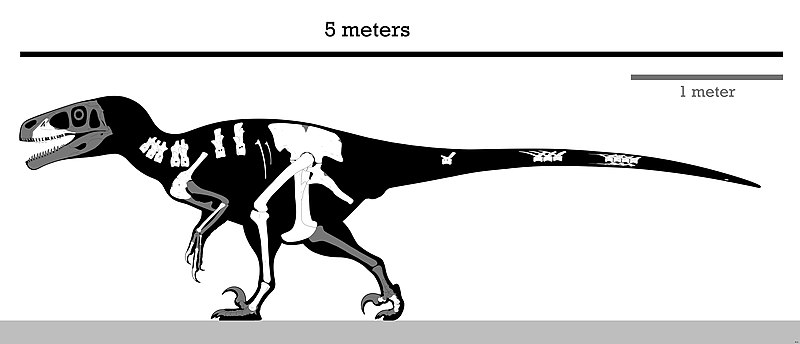| ОписAchillobator Skeleton Reconstruction.jpg |
English: Skeletal diagram featuring the size and known elements from the holotype of the large dromaeosaurid Achillobator giganticus. Being a member of the largest dromaeosaurids ever ( Austroraptor, Dakotaraptor and Utahraptor), its remains were discovered in Burkhant, Mongolia, from the Bayan Shireh Formation in 1989, and later described in 1999; however, in a very obscure and preliminar paper. [1]
The holotype of Achillobator, MNUFR-15, is fragmentary, consisting of a left maxilla preserving nine teeth and two alveoli, four cervical vertebrae, three dorsal vertebrae and eight caudal vertebrae, a nearly complete pelvic girdle compromising both pubis, right illium and right ischium, both femur and left tibia, left metatarsals III and IV, manual and pedal phalanges with some unguals, right scapulocoracoid, an isolated radius, two ribs and caudal chevrons. Traces of tail tendons were found too, but mostly isolated.[1] Although fragmentary, it is more complete than the respective holotypes of Austroraptor, Dakotaraptor and Utahraptor.
It was found as an associated, but overall disarticulated individual, however, it is known that some elements were found in semi-articulation[2], refuting a chimera hypotesis, as proposed by Burnham et al. 2000.[3] The missing elements were restored after close relatives like Utahraptor, Saurornitholestes, Dromaeosaurus and Deinonychus. Most estimates give Achillobator 5 to 6 m (16.4 to 19.7 ft)[1][2][4][5], in this case, the axial length ended up in 5 m (16 ft).
Color Key
_______________________________________________________________________________________________________________________
Español: Diagrama esquelético mostrando los elementos conocidos del holotipo del grande dromaeosaurido: Achillobator giganticus. Siendo miembro de los dromaeosauridos mas grandes ( Austroraptor, Dakotaraptor y Utahraptor), sus restos fueron descubiertos en Burkhant, Mongolia, desde la Formacion Bayan Shireh en 1989, y descritos mas tarde en 1999; sin embargo, en un informe muy preliminar.
El holotipo de Achillobator, MNUFR-15, esta fragmentado, consistiendo de una maxila preservando nueve dientes y dos alvéolos, cuatro vertebras cervicales, tres dorsales y ocho caudales, una pelvis casi complete consistiendo de ambos pubis, ilion derecho e isquion derecho, ambos fémures y tibia derecha, metatarsianos III y IV izquierdos, falanges manuales y pedales con algunos unguales, escápulocoracoides derecho, un radio aislado, dos costillas y cheurones caudales. Fragmentos de tendones de la cola fueron encontrados, pero mayormente aislados. Aun siendo fragmentario, es mas completo que los holotipos respectivos de Austroraptor, Dakotaraptor y Utahraptor.
Fue encontrado como un individuo asociado pero desarticulado, sin embargo, se sabe que algunos elementos fueron encontrados en semi-articulación, refutando la hipótesis de una quimera, como fue propuesto por Burnham et al. 2000. Elementos perdidos fueron restaurados basados en relativos cercanos, tales como Utahraptor, Saurornitholestes, Dromaeosaurus y Deinonychus. Varias estimaciones dan a Achillobator 5 o 6 metros (16.4 y 19.7 pies), en este caso, la longitud axial termino en 5 metros (16.4 pies).
References
- ↑ a b c (1999). "A new maniraptoran Theropod - Achillobator giganticus (Dromaeosauridae) - from the Upper Cretaceous of Burkhant, Mongolia". Contributions from the Geology and Mineralogy Chair, National Museum of Mongolia (101): 1-105.
- ↑ a b (2012). "A Review of Dromaeosaurid Systematics and Paravian Phylogeny". Bulletin of the American Museum of Natural History 371 (371): 1–206. DOI:10.1206/748.1.
- ↑ (2000). "Remarkable New Birdlike Dinosaur (Theropoda: Maniraptora) from the Upper Cretaceous of Montana". The University of Kansas Paleontological Contributions 13: 1–14. DOI:10.17161/PCNS.1808.3761. ISSN 1046-8390.
- ↑ (2007) Dinosaurs: The Most Complete, Up-to-Date Encyclopedia for Dinosaur Lovers of All Ages, Random House Genus List for Holtz 2012 Weight Information
- ↑ (2016) The Princeton Field Guide to Dinosaurs (2nd Edition), Принстон: Princeton University Press ISBN: 9780691167664.
|




